Knee Arthritis III-IV Degree — Total Knee Replacement: treatment in the Best Hospitals of Germany
Treatment prices are regulated by national law of the corresponding countries, but can also include additional hospital coefficients. In order to receive the individual cost calculation, please send us the request and medical records.
Treatment of Knee Arthritis in Germany
- Knee arthritis
- Arthroscopic or open surgery and transplantation of cartilage
- Diagnosis and conservative treatment
- Total knee replacement and rehabilitation
- Endoprosthesis replacement in knee arthritis
- Endoprosthesis replacement in knee arthritis with rehabilitation
- Collagen or Polyurethan (ACTIFIT) Meniskus Implantat
- Treatment with autologous conditioned plasma (ACP)
- Stem cell therapy
- Autologous chondrocyte implantation (ACI)
- Orthopedic rehabilitation
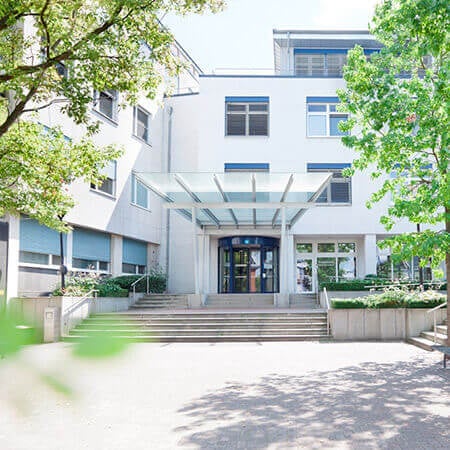
Department of Adult and Pediatric Orthopedics, Traumatology
The Department of Adult and Pediatric Orthopedics, Traumatology is part of the specialized Center for Musculoskeletal Disorders, whose medical team consists of highly qualified orthopedists, traumatologists, and spinal surgeons. The department offers modern diagnostics and treatment of the entire range of musculoskeletal diseases. The department's field of competence includes the treatment of injuries of varying severity. The therapeutic options cover both conservative measures and surgical interventions, which are mainly performed using sparing minimally invasive techniques. The treatment concept is based on the comprehensive approach – from the use of conservative methods to physiotherapeutic procedures the day after surgery.
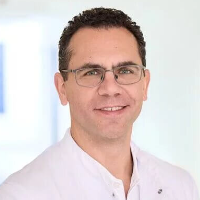



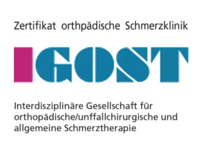
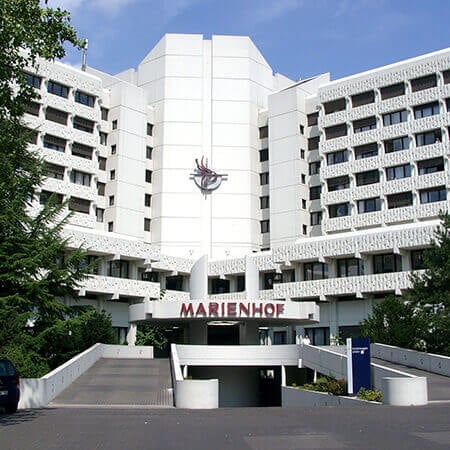
Department of Adult and Pediatric Orthopedics, Traumatology, Foot Surgery
According to the prestigious Focus magazine, the Department of Adult and Pediatric Orthopedics, Traumatology, Foot Surgery ranks among the top German medical facilities specializing in hip surgery! The department offers the full range of high-precision diagnostics and conservative and surgical treatment for diseases of bones, joints, muscles, ligaments, and tendons. One of the department's key areas of clinical practice is large joint arthroplasty. In this area, the department is awarded the prestigious endoCert certificate. The doctors in the department's operating rooms successfully perform knee, hip, and shoulder replacement surgery. Whenever possible, preference is given to minimally invasive joint replacement surgery. An important part of the work of the department's doctors is the treatment of orthopedic diseases and musculoskeletal injuries in children. The specialists at the medical facility also have long experience in helping patients with foot pathologies and deformities, including hallux valgus, hallux rigidus, hammer toes and claw toes, metatarsalgia, etc. The department's doctors have in their arsenal state-of-the-art equipment and modern treatment methods that allow for the achievement of excellent therapeutic results. More than 3,500 inpatients and about 17,000 outpatients are treated at the medical facility every year.
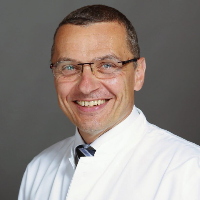

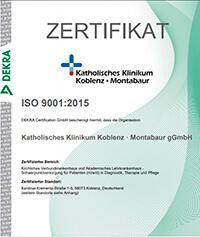
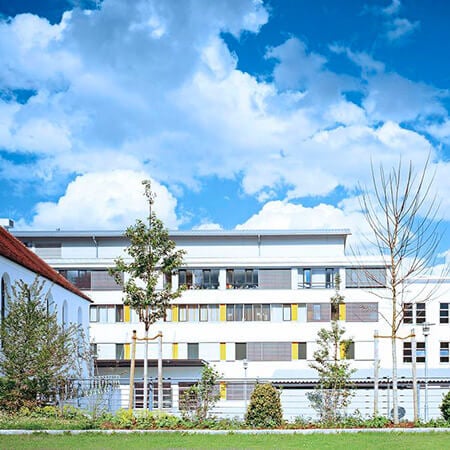
Department of Orthopedics, Traumatology, Spinal Surgery and Foot Surgery
According to the Focus magazine, the Department of Orthopedics, Traumatology, Spinal Surgery and Foot Surgery ranks among the top German medical facilities in treating orthopedic diseases and spinal surgery! The department carries out comprehensive examinations and effectively treats musculoskeletal diseases and injuries. The department has about 130 beds for its patient hospitalization. Doctors annually admit more than 4,000 patients for inpatient treatment. Several thousand surgical interventions of varying complexity are performed on the basis of the medical facility annually. The department offers the services of the certified Maximum Care Joint Replacement Surgery Center (EPZmax) and the certified Trauma Center. In addition, the department's specialists have vast experience in treating spinal and foot pathologies. The main goal of the department's doctors is to restore mobility and eliminate pain. The specialists always prefer an individual approach to each patient and his clinical case.






Knee osteoarthritis (gonarthrosis) is the second most common type of this disease after coxarthrosis (hip osteoarthritis). The risk of developing pathology during life is about 20%. Women are twice as likely to have knee osteoarthritis than men. In severe forms of pathology, total knee replacement surgery may be required. To get the best results with minimal health risks, you can undergo treatment in Germany.
Content
- Guidelines for gonarthrosis treatment
- Gonarthrosis surgery
- Types of knee replacement surgery
- Computer-assisted navigation
- Preparation for knee replacement
- How is surgery performed?
- Postoperative recovery
- Why is it worth undergoing surgery in Germany?
- Treatment in Germany with Booking Health
Guidelines for gonarthrosis treatment
Arthritis surgery is not a first-line treatment option. Most people undergo conservative treatment, with drugs and non-drug procedures. Arthritis progresses constantly, but very slowly. It can take years or even decades from the moment the first symptoms appear until the joint is completely destroyed.
The following methods can be used for arthritis treatment:
- Painkillers.
- Orthoses.
- Physiotherapy procedures.
- Intra-articular injections (hyaluronate, platelet-rich plasma, stem cells).
To relieve the knee, doctors advise shoes with shock-absorbing insoles, support on a cane, limited running, jumping and lifting weights. It is necessary to lose weight to reduce the axial load on the limb.
Physical exercises for the muscles of the thigh and lower leg are the only treatment method that provides not only short-term, but also long-term therapeutic results.
Drug therapy involves the use of nonsteroidal anti-inflammatory drugs. They relieve pain, but in 1% of patients, when taken regularly, they cause complications from the gastrointestinal tract that require hospitalization. The risk of complications is higher in patients over 65.
Additional methods:
- Intra-articular hyaluronate injections.
- Warming ointments.
- Opiates (only for severe pain, if knee replacement surgery is contraindicated).
Developed countries no longer use procedures for injecting glucocorticoids into the knee. These drugs have a short-term effect for arthritis, but they destroy cartilage and accelerate the progression of the disease.
The surgery improves function of the knee and walking ability.
Total recovery takes few months, but you’ll be able to walk in few days after the surgery.
Cost of arthroplasty in knee arthritis is from €11,721. You can find other prices on the Booking Health website.
Total knee replacement is substitution of the joint with a prosthesis.
The best hospitals in Germany are:
- University Hospital Rechts der Isar Munich
- Vitos Orthopedic Clinic Kassel
- University Hospital Ulm
- University Hospital Frankfurt-am-Main
- University Hospital of Ludwig Maximilian University of Munich
Gonarthrosis surgery
Most patients with stages 1-2 of the disease receive only conservative therapy. But with the progression of arthritis to stage 3, as well as in the absence of effects from medicines and non-drug procedures at stage 2, surgery is required.
Surgical options:
- Endoscopic interventions for cartilage resurfacing, removal of bone and cartilaginous growths.
- Creation of microfractures for the release of stem cells into the knee joint.
- Corrective osteotomies for biomechanical correction of the limb.
In recent years, similar operations in developed countries are used less and less. This is because they do not slow the progression of arthritis. The effect is extremely symptomatic, but after a few years, most patients require joint replacement surgery.
In addition, most of these surgical procedures are ineffective at stage 3 of the disease. At the same time, at stages 1-2, most patients do not need surgical treatment at all: they can only receive conservative therapy.
Joint replacement surgery is the most effective treatment option. It solves the problem of the degenerative process in the knee joint once and for all.
Here are some other radical surgical interventions for gonarthrosis, which actually leave a person disabled:
- Arthrodesis – removal of the joint and connection of bones (after surgery) the leg does not bend.
- Resection arthroplasty – removal of pathological tissues while maintaining joint mobility, but without implanting an endoprosthesis.
Arthrodesis can partially restore the limb support ability, but a person feels uncomfortable when sitting with a straight leg. After resection arthroplasty, the situation is reversed: the limb support ability is impaired, but the person feels more comfortable when sitting.
Types of knee replacement surgery
The knee joint is formed on one side by the femur, on the other by the tibia, which is located in the lower leg. Accordingly, the artificial knee has two components: the femoral and the tibial.
The patient's own ligaments are used as a joint stabilizer whenever possible. They provide better preservation of the artificial joint: it wears out more slowly, which means it is less likely to require replacement. To soften friction, plastic liners are placed inside the knee. They function as cartilage.
Knee replacement can be either total or partial. Total knee replacement involves the removal and replacement of all of its components: both femoral and tibial ones. When performing partial knee replacement, only one component is replaced.
Unicompartmental knee replacement
Unicompartmental knee replacement is the most sparing option. In some patients, changes affect only one condyle in the knee – either internal or external one. Unicompartmental prostheses are also called semi-prostheses, since they actually replace only half of the knee.
Depending on which part of the knee unicompartmental prostheses replace, they can be medial, lateral and patellofemoral. Surgery for their implantation are minimally traumatic due to:
- Short incision.
- Preservation of most of the patient's own tissue.
- Preservation of ligaments.
- Lack of muscle damage.
After partial knee replacement, the load on the bone remains the same, which prevents its atrophy. The normal relationships of the anatomical structures of the lower limb are preserved. All movements are felt by the patient as natural. Rehabilitation after "half" knee replacement is much faster than after total knee replacement surgery.
Total knee replacement
Severe osteoarthritis requires total knee replacement surgery. The patients who lead an active life, have intact connections and do not suffer from osteoporosis opt for mobile-bering platform artificial joints. They are good because they do not disturb the biomechanics of the knee.
Both sliding and rotating movements after replacement are provided due to the mobility of the liner. It takes over the function of the meniscus. The liner provides very slow wear on the artificial joint.
With complete destruction of the knee, its deformation, as well as for repeated knee replacement surgery, hinged endoprostheses are used. They replace the joint completely (total replacement).
For the patients with severe destruction of bone tissue and ligament failure, doctors use constrained endoprostheses. They contain mechanical stabilizers that take on the function of the ligamentous apparatus.
Computer-assisted navigation
Total knee replacement must be perfectly accurate so that the biomechanical axis of the lower limb does not deviate. Only in this case can one expect that the prosthesis will last a long time. The greater the deviation from the biomechanical axis, the higher the risk of aseptic loosening of the endoprosthesis, which is the main indication for revision surgery.
Modern computer-assisted navigation for total knee replacement helps to place the artificial knee very accurately by adjusting the location of the exoprosthesis components to a tenth of a millimeter, and their relationship to a tenth of a degree. With its help, the doctor can:
- Reduce the risk of complications after total knee replacement.
- Increase the service life of the prosthesis.
- Achieve an ideal balance of ligaments and other soft tissues, thereby improving knee function.
When performing total replacement without computer-assisted navigation, in 60% of cases, the deviation of the lower limb axis is 4 degrees or more. This means that 25% of these patients will have aseptic loosening of the endoprosthesis within 8 years of follow-up supervision. But with the use of computer-assisted navigation during total knee replacement, in 100% of cases the axis deviation does not exceed 3 degrees. The risk of endoprosthesis loosening within 8 years after replacement is only 3%.
Preparation for knee replacement
One should prepare for total knee replacement surgery in advance. A few months before the upcoming treatment, you should:
- Lose weight, if you are overweight.
- Quit smoking, as it impairs wound healing and increases the risk of infectious complications due to weak immunity.
- If possible, do arm and abs workout to make it easier to cope with crutches, walkers, and facilitate the initial rehabilitation period.
- Under the guidance of a specialist, receive the skills of walking with support, climbing stairs up and down, etc.
Immediately before the surgical procedure, you will need to undergo a number of laboratory tests and necessary diagnostic procedures. In the evening before the operation, the last meal should be no later than 6 pm. A few hours before total knee replacement surgery, do not drink water.
How is surgery performed?
Knee replacement surgery is technically more complex than hip surgery. Total knee replacement is longer, the risk of adverse outcomes is higher, and the results are more dependent on the equipment of the hospital, the experience and skill of the doctors. The surgical intervention takes one and a half to two hours.
The doctor opens the joint capsule, exposes the articular surfaces, and partially removes the bone. The surgeon also removes the surface of the patella facing the inside of the knee joint. Knee ligaments are preserved as much as possible. What's more, the doctor may even strengthen them to provide better joint stability after replacement surgery.
Artificial pads are placed on the treated bone surfaces. They are the same in shape as the articular surfaces of the knee. As a result, after the operation, the range of motion remains the same as it was before the development of osteoarthritis.
Upon the completion of the surgical intervention, the wound is sutured. The surgeons can leave thin tubes in it – drainages for fluid outflow. They are removed after 1-2 days.
Postoperative recovery
After total knee replacement, the patient takes antibiotics to prevent infectious complications and anticoagulants to prevent blood clots, as well as painkillers. On the first day, the patient can move in bed and do physical exercises. From the second day, the patient can sit down, and from the third day, he can walk.
Approximately 10 days after total knee replacement, the stitches are removed. During the same period, the patient is discharged from the hospital. He can go home or to a rehabilitation center.
Recovery in the rehabilitation center is more effective, as it ensures better joint function, allows fully restore the muscles of the limb, achieve ideal balance and form the correct walking pattern.
At the same time, high-quality rehabilitation increases the total cost of treatment for osteoarthritis, so not everyone can undergo it. In old age, when the patient has limited mobility and self-care is the ultimate goal of treatment, rehabilitation often takes place at home. A person only periodically visits a doctor to receive instructions from him for further rehabilitation treatment.
Why is it worth undergoing surgery in Germany?
The level of medicine in Germany is one of the most advanced in the world. This is one of the main reasons why this country has become one of the most common medical tourism destinations in Europe. The country offers a good ratio of quality and cost of treatment. Arthritis surgery can be performed cheaper than in other developed countries, but with the same outcome.
The main benefits of surgical treatment for severe knee arthritis in Germany are:
- Reliable surgery outcome. The risk that the second total replacement surgery will be required in the future is minimal.
- The use of high-quality endoprostheses. When implanted precisely, they can last for decades.
- Total joint replacement surgery is performed under the guidance of computer-assisted navigation. It allows to reduce the deviation of the biomechanical axis of the limb, which reduces the risk of aseptic loosening of the endoprosthesis.
- The use of Fast-Track rehabilitation protocols in order to reduce the risk of complications. Patients are discharged from the hospital after 4-7 days.
- High-quality postoperative care, adequate pain relief and symptomatic therapy.
After total knee replacement, one can undergo rehabilitation in one of the German rehabilitation centers. This country is one of the world leaders in the quality of orthopedic rehabilitation. Most patients fully restore limb function and permanently get rid of chronic pain.
Treatment in Germany with Booking Health
To undergo knee replacement surgery, please use the services of Booking Health. On our website, you can see the cost of treatment in different German hospitals, compare prices and book a medical care program at a favorable price.
Please contact the Booking Health specialists to undergo treatment in Germany. Here is what we will do for you:
- We will choose the best orthopedic clinic whose doctors specialize in surgical knee replacement.
- We will help you overcome the language barrier, establish communication with the German hospital and your attending physician.
- We will reduce the waiting time for the start of the medical care program and book a doctor's appointment on the most suitable dates.
- We will reduce the price. The cost of treatment in Germany will be decreased due to the lack of additional coefficients for foreign patients.
- We will take care of all organizational issues: documents for entering the country, transfer from the airport, hotel, interpreter, etc.
- We will elaborate a medical care program and translate medical documents into German. You do not have to repeat the previously performed diagnostic procedures.
- We will provide communication with the hospital after the completion of treatment in Germany.
- We will organize additional diagnostic tests, treatment in Germany or rehabilitation, if necessary.
- We will buy medicines in Germany and forward them to your native country.
- We will help you keep in touch with the hospital after completing your treatment in Germany.
Booking Health makes treatment in Germany easier, faster and cheaper. We will fully organize your trip, and you will only have to focus on restoring your health.
Authors: Dr. Vadim Zhiliuk, Dr. Sergey Pashchenko

